Drinking water for pigs in particular and water treatment in livestock farming in general is a need that plays an extremely important role, greatly affecting the health and development of livestock as well as directly affecting economic efficiency. economics of livestock farmers.
The role of drinking water for pigs
- If the body lacks water, pigs will grow slowly, lose weight quickly, toxins will increase in the blood, and the functions of body organs will be affected.
- In addition, dehydration in the first few days after birth is also a common cause of death in newborn piglets, especially in piglets that are underweight and do not get enough milk.
- Therefore, water supplementation is really beneficial for pigs and piglets following their mother, and these benefits are much greater than the cost of installing a system to provide enough drinking water for pigs.
Drinking water needs of pigs according to age
For piglets following their mothers: suckling piglets have little need for drinking water. The minimum amount of water required is provided through milk, because water makes up 90% of milk. The average amount of water consumed by piglets following their mother is 46 ml of drinking water/day/piglet (in the first 4 days). After the first week, piglets begin to learn to eat, so it is necessary to provide enough water for piglets at this stage.
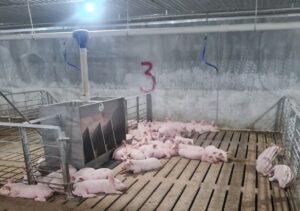
Drinking fountains and piglets at Nam Viet customer
- Lactating piglets raised in heated barns at a temperature of 28 – 320C, their water needs increase 4 times compared to suckling pigs in barns with a temperature of 200 C (as temperature increases, water demand increases).
- For weaned piglets: In the early stages, about 5 days after weaning, water consumption fluctuates less depending on physiological status and less related to body weight gain. The amount of water consumed in the first 3 – 6 weeks after weaning is: 0.49; 0.89; 1.46 liters/day/bird and proportional to the amount of feed consumed.
- For pigs raised for meat: For growing pigs, water consumption has a positive correlation with food intake and body weight. The minimum water requirement for pigs weighing 25 – 90 kg is 2.5 liters of water/kg of feed consumed. However, with different feeding methods, the amount of water consumed is also different: if fed freely, the amount of water consumed is 2.5 liters/kg of food; If feeding, limit the amount of water needed to a minimum of 3.7 liters/kg of food consumed.
- For pregnant sows: The need for drinking water in pregnant sows increases with the amount of food eaten. On average, dry sows (non-pregnant sows) consume 11.5 liters/day. Late-stage pregnant sows consume about 20 liters/day.
- For nursing sows: Nursing sows need a lot of water not only for metabolism like other ages but also to compensate for the 8 – 16 kg of milk secreted each day. The minimum need for nursing sows is 12 – 40 liters of water/day, on average 18 – 25 liters of water/day.
- For boars: The minimum water consumption requirement for boars is 20 – 25 liters/day/head.
Drinking water needs for pigs depend on body weight
– Pigs from 10 – 30 kg need 4 – 5 liters of water/day.
– Pigs from 31 – 60kg need 6 – 8 liters of water/day.
– Pigs from 61 – 100kg need 8 – 10 liters of water/day…
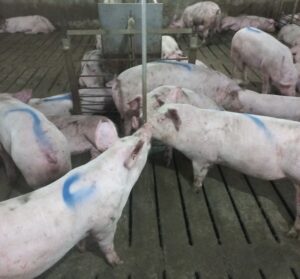
Pig drinking water with its trunk in its mouth
In addition, it should be noted that the daily water intake of pigs will increase (15-20%) in hot cases with temperatures exceeding the critical threshold of pigs and when pigs have diarrhea and water needs depend on Food quality and food type are also things that need to be considered.
Estimated daily drinking water needs of pigs:
| Type of pig | Liter/con |
| Pregnant and male sows | 12 – 15 |
| Laying sows and piglets | 25 – 45 |
| Laughing pig 25Kg | 3 – 5 |
| Adult Pig 45Kg | 5 – 7 |
| 65Kg growing pig | 7 – 9 |
| 90Kg growing pig | 9 – 12 |
Requirements for water quality for pigs to drink
Along with the problem of not providing enough drinking water for pigs, the effects of water quality are also very important. Poor quality water used in livestock production will affect the health of pigs as well as livestock productivity.
Require cool, clean water, free of toxic minerals and harmful microorganisms. In saline water areas, alum contamination (iron alum, aluminum alum) will have a negative impact on the growth and disease resistance of pigs. The appropriate pH is from 6.8 – 7.2, too alkaline ( >8) or too acidic (<6) are both harmful.
If you use surface water, you must pay attention to harmful microorganisms from the upstream of rivers and ponds.
+ If the water source is contaminated with E. coli bacteria: Sows give birth with no milk or no milk, the piglets of these sows will have diarrhea. In pregnant sows, it causes sepsis and miscarriage. Weaned piglets infected with E. coli will have diarrhea.
+ Water sources containing Salmonella spp or Clostridium spp can cause diarrhea in post-weaned pigs and piglets.
+ Pseudomonas spp causes mastitis and metritis in sows.
If you use underground water, you must pay attention to the minerals dissolved in the water. If the toxic mineral content is too much, it cannot be used to raise pigs.
- On the other hand, well water can also be contaminated (connected to surface water sources), so water quality must be periodically checked.
- If surface water or groundwater is contaminated with many harmful microorganisms, water disinfection chemicals can be used to kill pathogens before using to raise pigs.
- Rainwater is also a natural source that needs to be used, but we must also pay attention to the aspect of contamination with harmful microorganisms from dust mixed in the air contaminating raindrops. . To use this water source, it requires funding to build very expensive tanks and tanks. In surface water areas with a lot of silt, additional silt removal equipment is needed before disinfecting the water.
Therefore, the water supply for pigs should be suitable for the conditions of the farm, and it is necessary to build an effective drinking water treatment system for pigs. Water from the well/pond/stream… is pumped to the settling tank, the water in the tank and the bottom of the tank should be checked regularly for cleaning when necessary.
Then, pass it through the drinking water treatment system for pigs to be treated with appropriate technology, ensuring safety for pigs.
After being treated to high quality, the water will be put into a covered tank to avoid pollution and follow the pipeline system to the place of use.
Water pipes, drinking fountains, and water tanks must be cleaned regularly and the flow through drinking fountains must be checked. Regularly inspect the piping system by checking for sediment in the water at each drinking fountain.
Microorganisms, physical and chemical factors can affect water quality, so if there is any doubt about the quality, samples should be taken and analyzed. Water from drilled wells or ponds, streams, rivers, and lakes should also be tested periodically. Be sure to avoid wasting water and repair leaking pipes promptly because broken pipes will add more mud and dirt to the water.
(Reference source https://traigiongthuha.com)
Drinking water treatment technology for pigs installed by Nam Viet
Drinking water for pigs in the traditional way of raising pigs in the past can be done using normal well water and river water. However, today with advanced technology for raising pigs on an industrial scale in large quantities and at high densities, it is required. Water quality requirements for pigs are also higher and more stringent. Some of Nam Viet’s customers who raise pigs with high technology require very high water supply for the pigs to drink, the water must pass through RO pure water treatment system, however, the RO pure water system has a high price, customers who want to install an RO system for drinking pigs can refer to here

Diagram of RO technology to treat pure water for drinking pigs raised with high technology
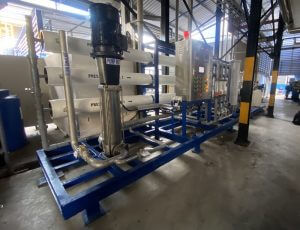
In addition, Nam Viet also installs water treatment systems that ensure quality and are sterilized before feeding pigs with appropriate technology and a lower cost than RO pure systems while still ensuring the required quality. input demand of livestock corporations such as Japfa, De Heus

Technology diagram of drinking water treatment for pigs designed by Nam Viet
- Coarse filter level: Removes all sediment and suspended solids in water
- Activated carbon filter level: Removes organic substances, odorants, and residual chlorine
- Softening level: Removes ions that cause hardness in water to limit sediment deposits that can clog pipes
- Fine filter level: Removes small impurities in water
- Ultraviolet UV light: After the water has been purified by the above 4 levels of filtration, the ultraviolet light will be responsible for destroying all bacteria and viruses in the water, ensuring the water source is free of pathogens. for pigs
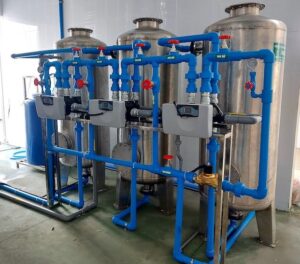
Drinking water filtration system for pigs installed by Nam Viet
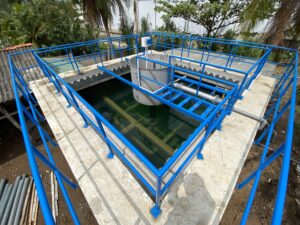
Nam Viet specializes in installing wastewater treatment systems, water supply, and drinking water for pigs. If you need installation advice, please contact Hotline 0932562177


Bài viết liên quan
Pure RO bottled water filtration system
What is a bottled water filtration system? The bottled water filtration system is essentially an...
Commonly applied water disinfection methods
Water disinfection is a mandatory step in the drinking and drinking process. Natural water contains...
Method of treating domestic water supply
Choosing technology is the most important step in water treatment techniques for domestic and industrial...